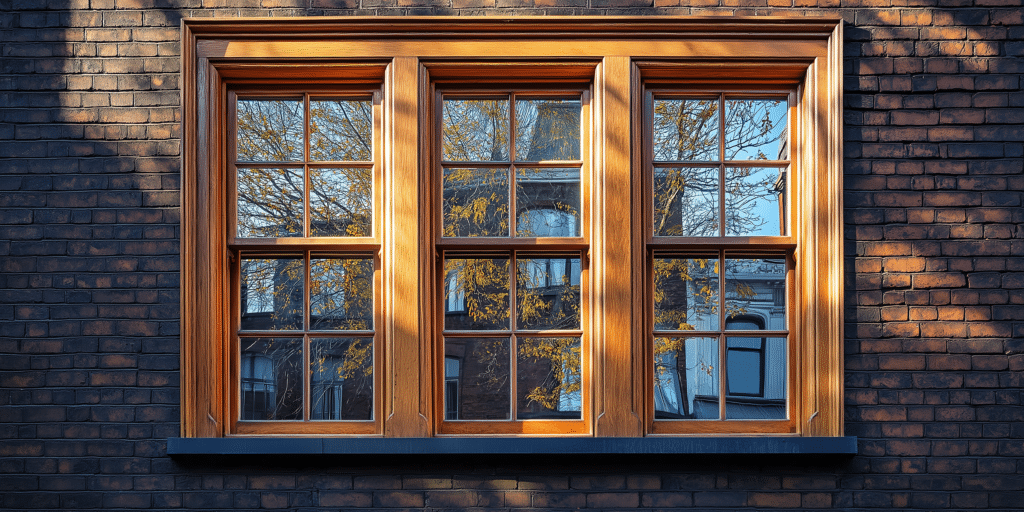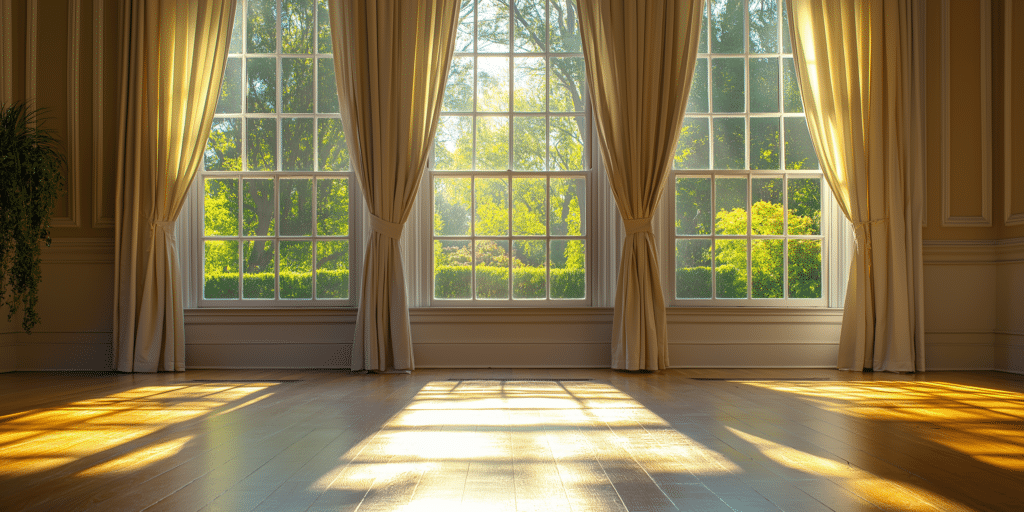What Is Double Glazing for Sash Windows?

Double glazing for sash windows involves fitting two panes of glass within the same window frame, separated by an insulating gap typically filled with inert gas, such as argon or krypton. This technology improves the thermal efficiency of sash windows by reducing heat transfer through the glass, which is especially beneficial for older homes where traditional single glazing is common.
Homeowners who opt for double-glazed sash windows in period properties experience reduced heat loss by up to 70% compared to single-glazed alternatives, significantly improving energy savings over time. According to recent industry data, the average home with double-glazed windows can save around £200-£250 annually on energy bills. Over the typical 20-year lifespan, this could total savings of approximately £5,000. This solution is particularly attractive to those in heritage properties looking to balance modern efficiency with historical aesthetics.
Benefits of Double-Glazed Sash Windows
Installing double-glazed sash windows has several benefits, the foremost of which is their ability to improve thermal insulation. With a second pane of glass and an insulating gap, double glazing significantly reduces the amount of heat loss through the windows, keeping homes warmer during the colder months and cooler during the summer.
Aside from thermal insulation, double-glazed sash windows also offer up to a 50% reduction in noise pollution, making them ideal for homes located in busy urban areas or near major roads and airports. A study by acoustic specialists shows that the insulating gap between double-glazed panes acts as a significant barrier to sound waves, creating a more peaceful interior environment. Moreover, homes with double-glazed windows often experience increased property values due to modern window systems’ enhanced energy efficiency, aesthetics, and security.
Retrofitting Sash Windows with Double Glazing
Retrofitting sash windows with double glazing is a popular option for those who wish to retain their home’s original timber frames and architectural style while benefiting from the modern advantages of double glazing. Retrofitting involves removing the existing single-glazed panes and replacing them with a double-glazed unit, which is carefully sized to fit within the existing frame.
For those in conservation areas or listed buildings, slimline double glazing is often used to fit within the existing frames, maintaining the original appearance while significantly improving energy performance. Research shows that double-glazed retrofits can reduce heat loss by up to 70% while still complying with the stringent regulations required for heritage homes. The cost of retrofitting ranges from £500 to £1,200 per window, depending on the type of glass and frame material used.
Energy Efficiency and U-Values in Double-Glazed Units

The U-value is a key metric used to measure a window’s thermal efficiency. It indicates the rate at which heat is transferred through the glass. A lower U-value signifies better insulation, making double-glazed sash windows far superior to single-glazing in terms of heat retention.
Double-glazed sash windows typically offer U-values as low as 1.2 W/m²K, compared to single-glazed windows, which can be as high as 5.0 W/m²K. This substantial improvement in thermal insulation contributes to energy savings and helps homeowners meet Part L of the UK Building Regulations regarding energy efficiency. By upgrading to double glazing, households can expect a reduction in energy bills by up to 30%.
Noise Reduction and Double-Glazed Sash Windows
One of the often-overlooked benefits of double glazing is its ability to significantly reduce noise pollution from external sources. This is particularly important for properties in busy city centres, airports, or major roadways. The insulating gap between the panes acts as a barrier that prevents sound waves from passing through.
In addition to thermal insulation, double-glazed sash windows reduce noise levels by up to 50%, especially when using specialised acoustic glass. This makes them ideal for homes near busy roads, airports, or urban environments, ensuring peace and quiet inside the home.
Cost and Value of Double-Glazed Sash Windows
The cost of installing double-glazed sash windows varies depending on several factors, including the size of the windows, the type of glass used, and whether the windows are being retrofitted or replaced entirely. On average, retrofitting double glazing into existing sash windows is more cost-effective than a full replacement, but the savings in energy bills and the increased property value often offset the initial cost.
Homeowners can expect to pay between £500 and £1,200 per window for retrofitting double glazing. Several factors affect the cost, such as the installation‘s complexity, the window’s size, and the type of glass used. A recent Homebuilding & Renovating Magazine survey shows that retrofitting can increase property values by 5-10% in period homes. Furthermore, double glazing has the potential to save homeowners up to £300 per year on energy bills, making it a sound investment in the long term.
Double Glazing in Conservation Areas and Listed Buildings

In conservation areas and listed buildings, strict rules often govern any modifications to the structure or appearance of the property, including the windows. Many homeowners are unsure if they can install double glazing in such properties without violating these rules.
In most cases, retrofit double glazing is permissible in Grade II listed buildings, provided it meets the guidelines set by local conservation officers. A slimline double-glazing unit can be used to maintain the original aesthetic of period windows while complying with conservation standards. According to Historic England, retrofitting can improve energy efficiency by up to 70% without compromising the building’s character.
Types of Glass Used in Double-Glazed Sash Windows
The type of glass used in double-glazed sash windows significantly impacts the window’s thermal efficiency, soundproofing, and security. Common options include low-emissivity (Low-E) glass, which reflects heat back into the room, and laminated glass, which provides additional security against break-ins.
Low-emissivity (Low-E) glass is particularly effective in reducing heat loss by reflecting infrared energy back into the room, making it ideal for homeowners looking to maximise energy efficiency. On the other hand, laminated glass comprises two layers of glass with an interlayer of polyvinyl butyral (PVB), providing enhanced security and durability. A Glass and Glazing Federation study found that Low-E glass can reduce heat loss by up to 35% compared to standard glass.
Maintenance and Care of Double-Glazed Sash Windows
Proper maintenance is essential for keeping double-glazed sash windows in good working condition. Regular cleaning and inspection for seal failure can help maintain efficiency and prevent problems like condensation between the panes.
Most double-glazed units have a lifespan of 20-30 years but can develop issues like seal failure over time. This results in condensation between the panes, which can sometimes be repaired but may require the entire unit to be replaced. Homeowners are advised to inspect their windows for signs of seal degradation regularly and to clean the glass with non-abrasive products to avoid scratching the surface. Experts recommend annual inspections to ensure that windows remain in optimal condition.
Long-Term Durability and Warranty Considerations

When investing in double-glazed sash windows, it’s essential to consider the long-term durability and the warranty provided by the manufacturer or installer. Most reputable companies offer warranties that cover glass failure, seal failure, and other potential defects for up to 10-20 years.
Most double-glazed sash windows come with warranties that range from 10 to 20 years, depending on the manufacturer. These warranties typically cover common issues, such as condensation between the panes or glass failure. Consumer reports indicate that homeowners should choose warranties that explicitly cover seal failure, as this is the most common cause of issues with double-glazed windows.
Environmental Impact and Sustainability
The installation of double-glazed sash windows can have a positive impact on both your home’s energy consumption and the environment. Improving your home’s thermal efficiency can reduce your carbon footprint and contribute to a more sustainable future.
Double glazing lowers heating and cooling costs and overall energy consumption, contributing to lower greenhouse gas emissions. Many companies now offer eco-friendly glazing options, such as windows made from recycled materials or sustainably sourced timber, which can help homeowners align their home improvements with their environmental goals. A recent study by the Energy Saving Trust revealed that double glazing can reduce a home’s carbon footprint by up to 20% annually.
Final Thoughts: Is Double Glazing Right for Your Sash Windows?
Double glazing offers an excellent solution for improving your home’s comfort and energy efficiency without compromising the historic charm of your sash windows. Whether you live in a period property, a listed building, or a modern home, double-glazed sash windows can balance style and functionality.
For most homeowners, the decision to install double glazing is based on the long-term benefits, including reduced energy bills, increased property value, and improved noise reduction, making it a worthwhile investment. A recent report by Which? states that double glazing can improve home energy efficiency by up to 40%, potentially reducing annual heating costs by £200-£250 per year. With the right care and installation, double-glazed sash windows can enhance your home’s overall comfort and value for years to come.




